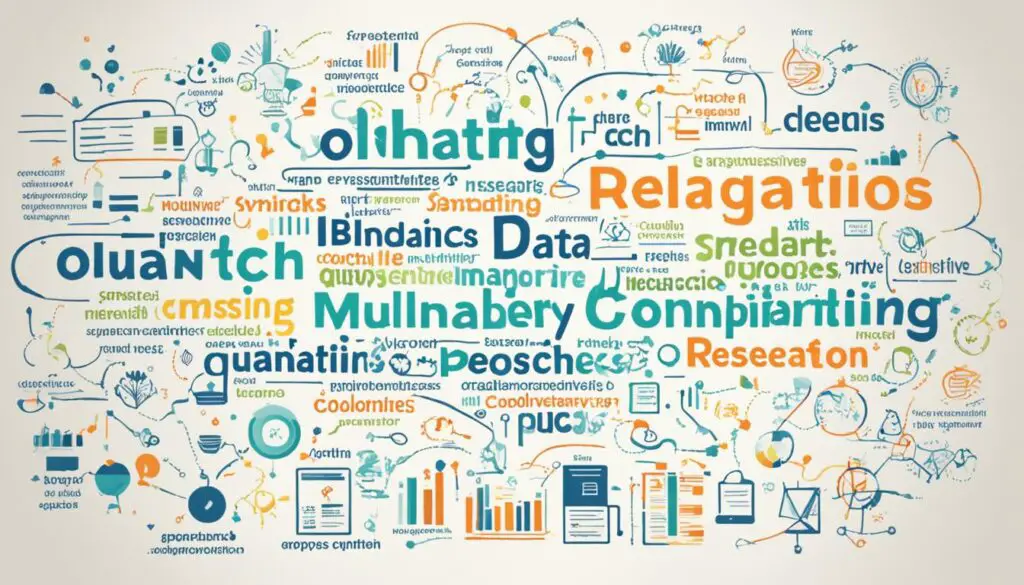Mixed methods research blends qualitative and quantitative approaches. It’s used to look deeply into complex topics. The Office of Behavioral and Social Sciences Research (OBSSR) wrote a report for researchers in health. The report gives excellent advice on how to use mixed methods in their studies.

Key Takeaways:
- Mixed methods research brings together the strength of both qualitative and quantitative data.
- The OBSSR report highlights the importance of working well in a team and using the right resources. This is essential for success.
- How you mix your methods matters. Using the right design and principles will make your research more valid and reliable.
- This method’s strengths include looking at a problem from different angles and gaining a richer understanding.
- But, it also comes with its challenges. You’ll need more time and resources. Plus, you have to be skilled in both kinds of data.
Integration Principles and Design Strategies in Mixed Methods Research
Integration is key to mixed methods research success. It combines both qualitative and quantitative data for a full view. This helps answer the main research question in depth.
Researchers use three main designs: exploratory, explanatory, and convergent designs. These methods allow them to collect and analyze data either step-by-step or at once. This way, they find detailed insights and links in their research.
For more complex questions, researchers can also use advanced designs. These include multistage, intervention, case study, and participatory frameworks. They are based on the main designs but offer more comprehensive ways to explore complex topics.
At the level of methods, integration looks at how to mix qualitative and quantitative data. Researchers can use various steps to do this. By combining data sources efficiently, they create a strong dataset.
When it comes to interpreting and reporting, integration is also important. By using specific narrative and data display methods, researchers can show how the data interact. This makes the findings clear and connected.
It’s important to know and use these strategies in mixed methods research. They help make the research valid and reliable. By mixing both approaches well, researchers can find deeper insights and make stronger conclusions.

Overview of Mixed Method Designs and Their Applications
| Mixed Method Design | Applications |
|---|---|
| Exploratory Sequential Design | Uncovering initial insights and patterns, generating hypotheses |
| Explanatory Sequential Design | Testing and validating hypotheses, providing in-depth explanations and context |
| Convergent Design | Concurrently exploring qualitative and quantitative data to gain a comprehensive understanding |
| Multistage Framework | Addressing complex research questions with multiple stages of data collection and analysis |
| Intervention Framework | Evaluating the effectiveness of interventions through a combination of qualitative and quantitative approaches |
| Case Study Framework | Investigating unique and intricate cases, understanding context and individual experiences |
| Participatory Framework | Involving stakeholders and participants in the research process, fostering collaboration and co-creation |
Strengths and Challenges of Mixed Methods Research
Mixed methods research has many strengths that boost its value in scientific studies. One key strength is finding the truth by using different ways. This checks if what they find is really true. The mix of qualitative and quantitative methods also helps understand things better. Each method brings out different info, giving a fuller picture.
This method lets researchers dive deeper into data’s surroundings and personal stories. Such depth makes the numbers come alive. It helps researchers really *get* the topic. The way mixed methods can change and adapt is also a plus. This adaptability lets researchers follow new clues or questions that come up.
But, there are difficult parts to mixed methods research too. It needs more time and money because it uses different tools and methods. Also, people need to be very good in both numbers and stories. They must know their stuff to use both kinds of methods right.
It’s not easy to mix and match data from different places. This part is tricky and needs a lot of thought. To beat these tough parts, researchers need to know what’s coming and plan well. With good planning, they can use the method’s strengths best. They can also deal with the hard parts better. This improves the quality of their work.
FAQ
What is mixed methods research?
Mixed methods research uses both qualitative and quantitative ways to study a topic. Researchers gather and analyze different types of information in one study.
Why is integration important in mixed methods research?
Integrating both types of methods helps in combining their strengths. This is done across the whole research process, from planning to the final results.
What are the basic mixed methods designs?
There are several basic designs in mixed methods. These include exploratory, explanatory, and convergent designs. Each one offers a different way to mix the research methods.
What are some advanced frameworks in mixed methods research?
For those looking for more complex approaches, there are frameworks like multistage and case study designs. There are also frameworks designed for specific purposes, such as interventions and participatory research.
What are the strengths of mixed methods research?
This approach brings many benefits. It combines the best of both types of research to get a deeper understanding. It allows for looking at a topic from different angles and settings. Plus, it is very flexible.
What are the challenges of mixed methods research?
However, mixed methods research is not without its challenges. It can be time and resource-intensive. Researchers need to be skilled in both types of methods. Also, combining different types of data can be complex.






